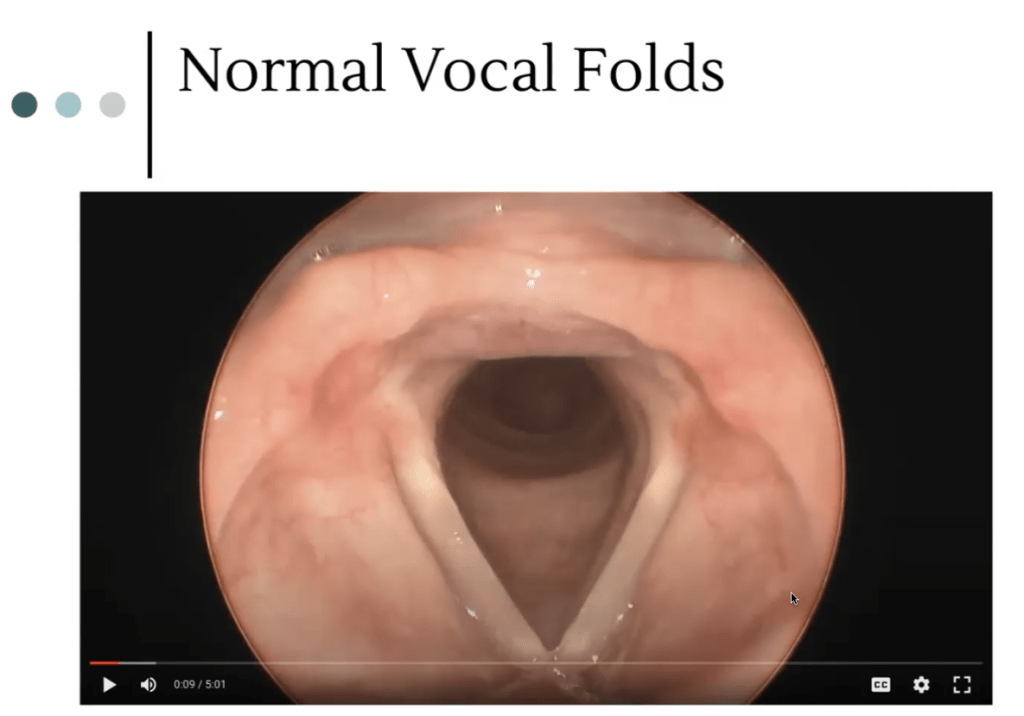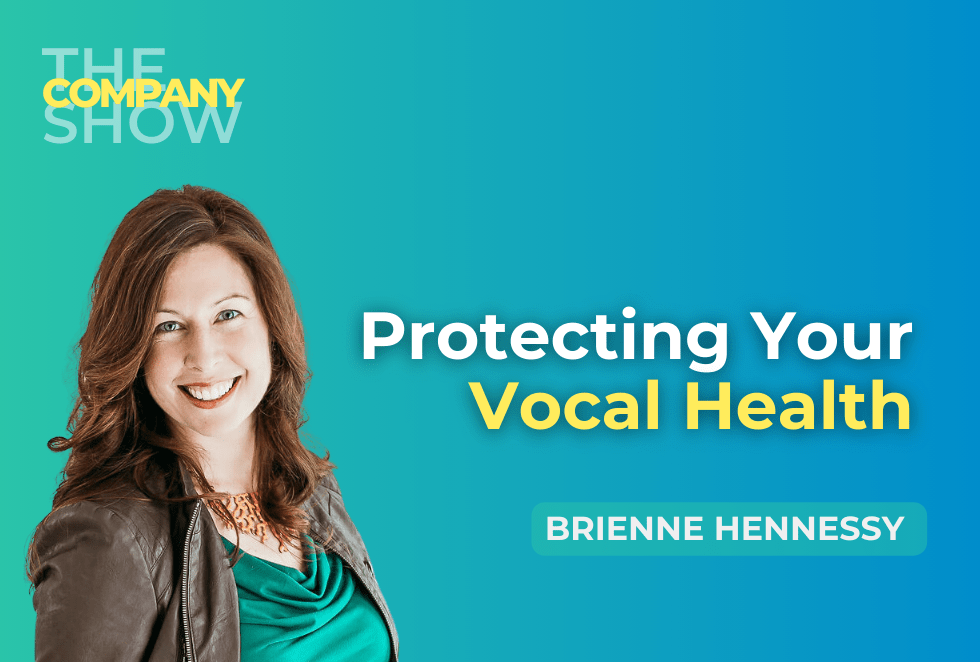Have you ever thought about the health of your voice?
The two concepts don’t go together intuitively to me, which is interesting when you think about it because the voice is something created with the body.
We’ve all had times when we lost our voice, or noticed it behaving differently based on our environment, situation or other kinds of health. But your voice is something that has it’s own health needs and as a podcaster, you should be aware of them.
When you start podcasting as a marketing channel for your business, you’re often not coming from a background where your voice is seen as a tool that needs to be cared for, but it is, and you should make it a priority.
It’s not just about how you sound in your recordings, it’s about preventing vocal strain, improving the longevity of your voice, and having more control over how you sound.
That is what I learned in my first conversation with today’s guest, who joined us for a Strategy and Networking Call in the Spring and totally changed how I think about my most important tool as a podcaster.
Today I’m sharing the training that Brienne Hennessy, a licensed speech-voice pathologist and the founder of Your Vocal Vitality, gave us in our strategy and networking call back in the spring.
She is teaching us how voice care is self-care and the mindset shift you need to make about it, what voice triage is, and how to actually improve recovery when we do have vocal difficulties, and some practical tips for preparing your voice before an interview. (Including a vocal exercise I experimented with live on the call!)
This training did have a video component, so if you’d like to watch, you’ll find the video below!
Listen to the episode, watch the video, or continue reading the blog post!
Tune in to the full episode to learn about:
- Vocal health issues and challenges
- Understanding the voice box: larynx
- Addressing vocal problems and daily strategies
- The power of warming up
- Misconceptions and clarifications on vocal health
- How to take care of your voice in a sustainable way
Don’t forget to join us for our free monthly strategy calls on the third Thursday of every month!
Here’s the recording of the Strategy and Networking Call
This includes all the exercises and other fun bits that might have been cut out from the podcast version!
Vocal Health for Podcasters
Brienne: “You’re all here, because you are interested in podcasting currently podcasting have been podcasting for years.
Not often is one of the most important assets that you need to do said podcasting talked about in a way that really looks at the wellness and health and care. So that is our goal today, protecting your voice health while podcasting.
When you think back, have you ever lost your voice? Have you had a singular incident for any reason? Have you had multiple incidences? Do you know someone who struggles with their voice?
In that situation, what did you do? Were you able to take off work or adjust your schedule? Did you have to keep pushing through and just talk and get things done? Is it something where you wake up assuming your voice will be there for you in the way that you expect it to?
If so, you’re not alone.
A lot of people take their voice for granted until something changes, until something starts to shift in the quality or the feeling or the performance of it that makes them start to worry and second guess, will my voice do what I need it to do?
Are there times where you’ve ever been misunderstood? When we think about communication breakdowns, one of the most common things is being misunderstood because of tone of voice. They didn’t like the tone of voice. They thought that you should be communicating in a way that only worked for them and that can really start to degrade the communication interaction.
That can also create a sense of nervousness and stress when having harder conversations, asserting yourself. If your tone of voice doesn’t match what you’re trying to say, that can really impact the listener.
Overcoming Societal Bias and Self-Criticism
Of course, we always have the component of bias in our society and unfortunately, there is a lot of bias against voices. Have you been ridiculed because of the sound of your voice? Have you been told that you need to sound a certain way because you’re too shrill, too brash, too high, too low?
Are you a woman who has tried to change her voice in order to match some version of authoritative, matching peer interaction to make sure that you are heard. If so, you’re not alone.
That is really all too common and something that weaves into how our voice can carry so much presence and power and how it can also be out of alignment and not resonate when it’s meant to.
Are there times where you yourself have finished recording a guest speaker engagement or starting your podcast and wanting to edit your recordings and you listen back and you feel like:
Oh, okay. I don’t really hear the sound of my voice the way I thought I would. Maybe if I just change it to this, this’ll be more like I’m supposed to sound.
Or maybe if I really get a little bit softer and kind of bring my volume down, that will sound more pleasing.
Ultimately not feeling quite like yourself.
Or maybe there’s times where you literally hear your voice and this happens. You criticize yourself. You have that little mind chatter internally saying, Oh, No, this is no, I do not like the way that sounds.
I’ve had too many people tell me they actually use the word hate with the sound of their voice and they hate the way it sounds and my question to you is, how can you hate the very thing that you’re using to communicate your message with the world?”
Your Vocal Vitality
Brienne: “As we alluded to a little bit in the intro, why I’m here is because this mission became very important to me over the years that I spent in voice clinics around the country, assessing and rehabilitating thousands of different types of voices, people who had already gotten to the point that they had to seek specialty medical care.
In that time, a lot of things I would hear is, I didn’t know I could take care of my voice. Why me? Why now? I’m 40, 50, 60 something years old. Why is this happening?
There’s a big gap and lack of preventative wellness when it comes to the speaking voice. Most people think of voice and think, oh, well, singing, but I don’t sing. That’s okay. Most singers need help with their speaking voice as well because we use it the most out of all the things we do in communicating as humans.
In 2019, I started my mission at Your Vocal Vitality, really looking to up level the health and wellbeing of the voice, both the physical component and our intuitive inner voice—that knowing that when they resonate, we show up and speak as our truest self.
I have been so, so blessed to be a guest in over 50 different types of speaking engagements and I’m just so glad again, that Megan has brought forth such a powerful and lesser known aspects of this industry.”
The Larynx: More Than Just Your Voice Box

Brienne: “Do you know where your voice is located?
The voice is in the neck of the organ called the larynx, specifically right at the Adam’s apple. So if you put your finger right at that notch and you swallow, it’ll bob up and down. That notch is the Adam’s apple, usually a little less prominent than in women than men.
The vocal folds sit right behind that. So they’re in a V shape and the front is the point of the V and they’re opening and closing for both of you right now, they’re open because you’re breathing—for me, they’re closing hundreds of times a second because I’m talking now.
We need air to make the vocal folds vibrate and yes, the vocal folds themselves, the actual vibration, them colliding hundreds and thousands of times a second, is what makes a sound.
Now, is the larynx, the voice box, primarily for voicing and for speaking? I think it’s not so sure. Interestingly, biologically speaking, it is to protect our airway from things going down the wrong way.
How many of you have choked or coughed on something when you’re like, Nope, that is not there. Yep. That is not the right tube. So the food pipe and the wind pipe, the esophagus and the trachea, they share a wall, they back up right to each other.
Evolutionarily speaking, we got this bonus of being able to evolve and communicate with all these gymnastics we do to speak—but all really the larynx and the brain care about is that nothing gets into our lungs.
That’s why it can close when we cough, it can close up to make sure that when we swallow, we are safe.”
Shaping Your Unique Sound
Brienne: “We’ve hit on one thing. It’s partially the vocal folds making this sound.
Interestingly, if that air and sound, when combined, don’t have anything to travel through, it’s just a buzz. So once we put our unique shapes of our head and neck on top, we can elicit our unique sound. So that’s why we can each sound different.
When we speak or sing, do we do so on the exhale or on the inhale?
It’s not meant to be a trick question, but purely because we want to be attuned to how we’re optimizing the system. I did have some folks over the years, based on some injuries that they had, that had to start speaking on the inhale. So it’s possible, but exhausting and challenging in its own right.
You hit on the three systems that make up our ability to create the sound that we do. We need to have the power support of the breath. We need to have the sound source coming from the vibration of the vocal folds, and we need to have that filter resonating that sound in whatever way that we can that sounds most naturally like us.
So these are just, again, some fun anchors for anatomical reference. These are a lot of components coming together to create what we can do each and every day so I won’t spend a lot of time.”

Brienne: “This image I particularly love because as you can see, when it’s all put together, these are sound waves. We have actual vibration and energetic waves coming out but if you notice, the sound isn’t just going unidirectional, it’s also reflecting back in.
This is important because as these spaces are amplifying or dampening the sound, we can manipulate it to our benefit to ensure that we’re using it in the most optimal way. That’s what I really think is cool about our system and that’s one of the things I want you to be able to recognize today that your voice has lots of capabilities and it’s just a matter of harnessing that natural sound to you.”

Brienne: “These are vocal folds. Yes, sometimes people think the body is reduplicative and I’m okay with that.
People usually feel a little like, Whoa, when they see this, but I think it’s important because think of any other instruments in the world. We can see it. We can touch it. We can take it apart. This instrument lives in the dark in our neck.
The fact that we can look and see, we can check out how it’s anatomically functioning. These white structures here are the vocal folds themselves. They come together to make the sound down the hatch there’s the trachea.
Like I said, the point, the V portion is towards the front of the body. So the way that the camera is oriented and they open in the back as the person is breathing.
Now, we’re gonna look at them vibrating. This is important because when we see vibration, it actually vibrates too fast for the naked eye to appreciate. We need to use something called a strobe light, like a strobe light on a dance floor, that is gonna slow down the motion so that you can see simulated slow motion of vibration.
So they’re floppy. They need to be, if they were stiff, or scarred, or if there were lumps or bumps on there, that would impact the vibration—and thus the sound would change.
They are coming together at that pitch about 210 times a second. Now, high pitch, this is closer to about 500 times a second they’re vibrating. That’s closer to about 700 times a second they’re vibrating.
That’s every single day, whether you’re speaking, singing, whatever it is, this is high impact, okay? So a lot of stress strain.
Fun fact, you also got to know me really well, because those are my vocal folds. You’re welcome.”
Recognizing and Addressing Voice Issues
Brienne: “Now, when we think of this athletic endeavor that is speaking, most of us don’t take a lot of time to think about it until something does go wrong. We won’t go into all the nitty gritty of pathology, but I want to kind of touch on some shifts or changes to be aware of.
Quality Change
So one thing would be a quality change. If you’ve ever had that hoarseness or scratchiness, the voice is cutting in and out, and that’s lasted for longer than two weeks, that is a concern.
You would need to speak for sure to someone like me or to another specialist in a voice clinic. In the meantime, if that’s happening, but it’s intermittent, that’s still not normal. The voice wants to work optimally. Sometimes we just get in the way of it. We don’t mean to. It’s just kind of human nature.
If you’re experiencing fatigue with voicing. So I just spoke with a woman the other day. After one hour of lecturing, she’s already vocally fatigued. That is not normal. That is something that needs to be addressed as well.
That’s when you would say, okay, Brienne, what are we going to do about this? Because this is something that is going to impact how much you’re able to do in a given day.
The other thing that some folks notice depending on what they’re doing is they go to laugh or maybe they are playing around and their voice goes to higher pitch, but the pitch doesn’t come out. There’s just no sound or there’s a crack.
That’s also a sign that something may be going on and so again, it’s important to have that screened and listened to. I do free voice health screenings because it’s important to kind of sense what is my normal and what is not, and what is my baseline?
Frequent Throat Clearing
If you’re throat clearing here and there, fine. Remember what we talked about evolutionarily, that’s kind of clear out whatever’s not meant to be in your airway.
But if it’s a constant or you’re doing it to start talking, I hear that a lot, even for podcasters who’ve been doing this for a long time and then they start talking. That’s actually your vocal folds telling you as a signal that something is not quite right.
They shouldn’t need that to get going, but people are like, I’m just starting my voice. I’m jumpstarting my voice. So excess throat clearing can be assigned to watch out for as well.
Things That Impact Your Voice
These are all signals. Our voice, I believe is a barometer for our whole body and our wellness and so when you listen to it and kind of gauge where you’re at, it can make such a world of difference.
So there’s different things that can impact those symptoms that I mentioned. Sometimes it’s just how much you have going on with your voice.
- If you have to talk a lot,
- you have to talk over noise,
- if you have kids and you holler room to room in the house,
- if you are speaking, doing a presentation, but not using a microphone,
- if you talk loud just because that’s your personality, but at the same time, don’t necessarily have kind of the other end of the spectrum of kind of having some rest or quieter times.
All of that can make a difference in how much the voice can handle. This is a very resilient instrument. It’s just not invincible.”
The Vocal Athlete

Brienne: “With that, the term for you all is a vocal athlete. As a vocal athlete, you are running this vocal marathon every day.
No marathon runner would get up off the couch and be like, today’s the day I’m gonna run a marathon. There has to be that conditioning and training and any athlete in their sport will tell you that that is just an inherent part of how they keep their peak performance every single day.
And so again, most people think of this for singing. It doesn’t just fall to singers. This is something that we do so often, and especially in this time now of both virtual and live and podcasting and batch recording. There’s so much that we can do to increase our voice use and we can do it. We just need to do it in a really smart, strategic and healthy way.
So let’s jump into some tips.”
I would like to normalize sipping during your podcast, sipping during lives.
Brienne: “I can’t even tell you, especially like hashtag 2020 and on, people would do lives for like two hours and not take a single drink. I was like, what is happening right now? So it is okay to pause and sip.
When we think of hydration, most of you probably have a pretty set amount in your head. Oh, if I drink eight glasses of water a day, that’ll be plenty. Maybe—everybody’s unique.
Every situation is unique and there’s environmental factors, there’s medication factors, some medications have drying side effects, and there’s also just use factors. If you’re talking a lot, you’re gonna dry out more.
So when you’re looking at your water amount, I want you to base it first on half your body weight in ounces as a starting point. I know, some of you are like, I’m sorry, what? I promise it’s going to seem like a shift, but ease into it.
Yes, it’s OK to have to go to the bathroom or let the toxins out and at the same time, you can adjust based on what you’re doing. But you’ll notice if you’re feeling thirst or even that sense of dry mouth outside of any other medical issue, that’s already you being on the under hydrated side. So definitely look at your hydration amount with water.”
The Vocal Mist
Brienne: “The second thing that’s often overlooked is what we need to get from a surface hydration standpoint. This would be like putting lotion on our skin. So if you notice, wow, I feel great after a steamy shower, or I do the old school boil water, put the towel over the head, breathe in the steam.
Awesome. That’s incredible. That’s going to be really helpful for the surface tissue that does need some more immediate hydration. The other thing that you’ll see in the gift handout that Megan will send you guys the link for is a device like this.
This is a little portable nebulizer called the VocalMist. So while you can see on here, there’s facial steamers and different things.
This is really cool because it’s portable rechargeable and you’re literally getting mist that is designed to impact and stay within the larynx, not just disappear into the mouth or into the lungs and not, not help. So that I really like.”
Daily Strategies for Vocal Health
Brienne: “For podcasters, I had a couple of clients who were also regular podcasters and they would do it before recording and after recording the fatigue level and the consistency in their sound was so much better, even after something simple like that.
Again, when we look at just what are the things to keep an eye for, and if you’re ever unsure, just let me know because it’s important to, again, calibrate to what your voice needs.
Do your triage. There are things that you can do to make sure that you’re not pushing through the voice because it’s a very slippery slope to say, it’ll get better. It’s still a little scratchy. I’ll just do one more recording. I’ll just do that one more phone call.
That’s not always that true threshold of what it’s capable of until you wake up the next morning and you’re like, Oh, now I overdid it. So always kind of look kind of strategically ahead at your week.
There are some things that you can do very simply, even in a week.
If you look at your week and you’re like, Ooh, this is a tight week and I want to get these recording recordings in and I have these other events that I have to do. It may be a factor of just sprinkling in more voice rest time.
Voice rest alone will not cut it because this voice, like an athlete needs to be conditioned. So again, no athletes going to be like, well, I really have to get ready for the next season. So I’ll just rest. No.”
Voice Naps
Brienne: “These are the things you can do, though, sprinkling in little kind of voice naps between if you’re recording a lot between episodes. If you are speaking with clients or potential clients or family, or, again, in background noise. It’s important to just notice, am I resting my voice at intervals? Am I making sure not to over-project, even with the microphone right here, just because I feel like I need to be heard? So monitoring even just the voice volume can make a huge difference.
Let the mic do the work for you. Your mic is there to support you.”
Managing Phlegm and Hydration

Brienne: “The other piece to the tips that you’ll see in there is—I I’m going to presume from prior folks that I’ve worked with in podcasting and voiceover that phlegm is an issue for some of you. We all have it, mucus and phlegm. It’s a thing.
Some of those tips we’ll go through as well. The importance of how the hydration is going to help phlegm, but also things like lemon in your water can help because the tartness is going to activate the salivary glands, which will cut through some of that thickness, that cotton mouth feeling.
It’s usually more important for voiceover artists, not to have that like a moist mouth sound, not so much necessarily for podcast hosts, but knowing that you’re already feeling sticky and thick in there means that you need to hydrate at least 24 hours before more and having that lemon can help really cut through.
That’s the other thing I like about the nebulizer, in particular, if you have phlegm from allergies, if you have sinus things going on and you are doing nasal rinses and gargling saltwater, that’s all going to flush that stuff through that wants to otherwise kind of hang out and disrupt the flow.”
Power Up with Vocal Warm Ups
Brienne: “The final thing, when we are looking at what is important, even beginning of your day, but certainly before you sit down to record, whether you’re solo or whether you are interviewing in your style of podcast is warming up.
Again, this is not just for singers, warming up your speaking voice means that you are showing it where it can optimally be. You are improving the quality of the sound, which we’d go back to that bias.
Unfortunately, even radio hosts, journalists, et cetera, a lot of folks are here. They kind of live in this space when they talk, they don’t always start there, but maybe it kind of drops down a little bit. This is called glottal fry.
Now for some people, this is no big deal for others. They want to turn it off immediately and they will not be tuned back in. Now that’s something that even for you as the speaker can get fatiguing if you’re stuck there for too long.”
Avoid Monotonicity
Brienne: “The other thing that I see a lot is the monotonicity. So either too monotone in volume, too monotone in pitch, and that’s just not as engaging for the listener, which is important.
This is your audience you’re trying to reach and captivate, but for you too, if your voice is kind of stuck here in this kind of space, and you’re just kind of living in the same zone all the time., that’s putting like this dampening effect on your whole expressiveness.
That’s going to be fatiguing and potentially get things out of whack with how your voice can best work.
So in those examples, I’m sure, again, we usually know someone who is maybe sounds like that, or if you notice your voice kind of hanging out in those modes, warmups can be a great way to play with that.”
Brienne Hennessy’s Vocal Warm Up
Brienne: “So that is the overview of what I wanted to give you all today. Again, your voice matters.
That’s why you’re here. That’s why you are putting your creativity out into the world in podcast form and any other form. I just hope that you now see this instrument as such a crucial part of allowing your podcast to shine even more.”
What’s actually going on with dairy?
Brienne: “I get this a lot. It is one of the myths, interestingly, out there about how it impacts the voice. So dairy itself is going to depend on, of course, the person, especially those who are intolerant, they’re going to have different reactions to it.
Ultimately, the ingredients or components of dairy are what can activate some of that thickness and that feeling of cotton mouth. So not everybody experiences that. That’s why people say not on the day of or just before, because they’re going to feel it kind of in the mouth and the throat area.
Unless you’re sensitive to dairy, again, it’s going to take a while, hours to digest. So it’s not necessarily related directly to digestion unless it triggers reflux, acid reflux coming up and if it comes up to the level of the throat, that can cause irritation, which then can change how you’re trying to sound and speak.
So going back to, can you have dairy on the day of or not? You’ve got to play with it. It’s up to you.
Sometimes it’ll make zero difference. If it does make a difference, grab that lemon water. Get that and start swishing, spitting that out. Get that cleared out, because that’s, again, it’s just some of the proteins and components in dairy that’s going to thicken the mucus that’s there. That’s the biggest issue with it.
And remember, nothing you swallow touches your vocal folds. So if you’re like, I don’t do dairy the day I record or speak, but I definitely do extra virgin olive oil. People legit do that. Not touching the vocal folds, please don’t let that happen.
But it’s also very anecdotal. It’s just going to feel soothing to some people. Other people feel like nothing. So that’s where I really go back to these multifactorial components.
Again, you can do those things all day, but if you’re not actively doing something like a warmup, like the physicality that your voice requires, it just won’t matter.”
Nervous Laughs and Other Mannerisms
Brienne: “That is something that absolutely can be shifted and transformed.
A lot of times it can be related to nervousness and we go back to how do we truly connect with and activate the parasympathetic nervous system. That’s our rest, digest, relax state, and make sure that we’re feeling the most comfortable first and foremost.
But also, if we’re more disconnected from our body and our breath in that moment, we’re up here, a I tend in general to find this more with fast talkers and people who feel like they want to get their message out and they better do it and make sure it’s like, go, go, go, go, go.
Sometimes even just understanding and respecting the power of the pause can be really helpful for both you and the listener.
As for the nervous laugh, yes, that can be foundationally addressed first by preparing and priming for the nervousness.
But if that’s something that comes up because of whatever’s being talked about or the moment or, just how you’re truly feeling and you’re expressing—that’s okay. It’s your voice showing who you are and trying to be as honest and authentic as you can be.
If you’re able to then say, Oh, yep, I notice, and this is what I’m feeling underneath that, and transmute that into something else you want to say about it, or just know for yourself that like, okay, cool. That’s how I was feeling. Good to know. That’s you being you.
And that’s where we didn’t get into it as much today, but that’s where the intuitive voice and the alignment with what is your body embodying when you speak makes this go to depths that people are always just astounded with.
This is not just voice exercises that I do, even though that’s what you all mostly saw today.
It’s one of those things that I never want anyone to change who they are and how they express themselves. I want them to step into who they are becoming and the potential that that voice and speaking power holds for them.”
Vocal Health Tips: Start Small and Be Consistent

Brienne: “Most of us are overachievers in this world. Don’t do all the tips at once. Pick a couple that you are like, oh, yeah, I want to try that I could maybe do a little bit better with that.
I look at it as anything relative to like a health and wellness routine. So you get up and brush your teeth every day, you know, get up and add this to something you already do pretty habitually, that serves your well being.
This can be maybe a segment of two weeks that I encourage you to make a shift, choose that you’re going to do it every day. Anything less than even once a day with some of these more concrete things.
For example, if you were to do the VocalMist and you’ll see, that once a day is plenty to start with, but if there are times where it needs to uptick, then maybe you do twice a day.
But things like hydration—yes, please be hydrating every day. Things like, soothing the throat.
I have a client right now and we created kind of her morning routine to soothe her throat, feeling good. What feels good. She just discovered, for example, that hot water, honey, and lemon can be really soothing.
Even when there’s not yet like a sore throat sensation, but she discovered that honey in the morning for her doesn’t feel as good to her as just doing the hot water and lemon, for example. So she adds that later in the day. You see what I mean?
So I’d love for you to explore it, but give yourself some parameters—I want to change one or two things at most and try it for the next couple of weeks and then go from there
I think the biggest thing is when you start to notice a shift, it may be pretty subtle. Most people go, it wasn’t until I stopped doing it that I noticed that it actually helped.
That’s really common with voice and I think that’s just because similar to other parts of our body, like when we’re starting a new workout regimen, sometimes we don’t actually see the changes until we’ve stopped for a period of time.”
Sinus Issues
Brienne: “With sinus things too. That’s the nice thing about jumping on a call anytime. They’re easy to kind of talk through.
With sinus stuff, it is so individual. If do you do the saline rinses, don’t overdo those, because those can be drying if you overdo them. I usually recommend folks to do a few times a week, unless allergy season’s really wreaking havoc on them, versus too excessively.
So yes, that’s where maybe just trying one or two of the things, because anything that you’re soothing up here is going to have a downstream positive effect into throat, as you know.”
Final Thoughts
I just loved this training and the conversation we had afterwards! I’ve made some changes to my own recording preparation, and am starting to advise our clients on how to do the same!
If you want to attend these strategy and networking calls, Id love to see you there to learn from experts, get your personal podcasting issues sorted, and network with other professionals that podcast. You can find all the details and register for free here.
Next week, I’m excited to share another podcasting for business case study with you—Heather Grey is the host of The Lyme Boss, and is doing some amazing things optimizing for multiple different revenue and opportunity streams. I particularly like her Affiliate Marketing strategy and approach.
Here’s a quick preview:
Affiliate Marketing has an interesting reputation in the internet marketing industry but it can be a very legitimate method of adding an income stream to your podcast—the more well-targeted it is, and the more engagement and knowledge you have of your audience, the better it will work.
This will be a case study not to miss if you’re interested in diversifying the monetization options for your podcast.
Make sure you’re subscribed on your favorite podcast purveyor so you don’t miss it!
Be A Guest on The Company Show
Do you have a podcast that’s making a major difference in your business or know one that is? Fill this contact form and let us know about it.
We’d love to have you here for a case study episode like this one!
Need A Podcast?
As always, this is Megan Dougherty, and The Company Show was made possible by the team at One Stone Creative.
If you know a business owner that you think should have a podcast, do us a favor and send them to podcastingforbusiness.com!
Key Quotes
“I’ve had too many people tell me they actually use the word hate with the sound of their voice and they hate the way it sounds and my question to you is, how can you hate the very thing that you’re using to communicate your message with the world?” – Brienne Hennessy
Resources
One Stone Creative | LinkedIn | Twitter | Facebook | Instagram
Make sure to check out our free Monthly Strategy Calls!
Podcasting for Business Conference 2023 Recordings
Learn about what other business podcasters are doing:

